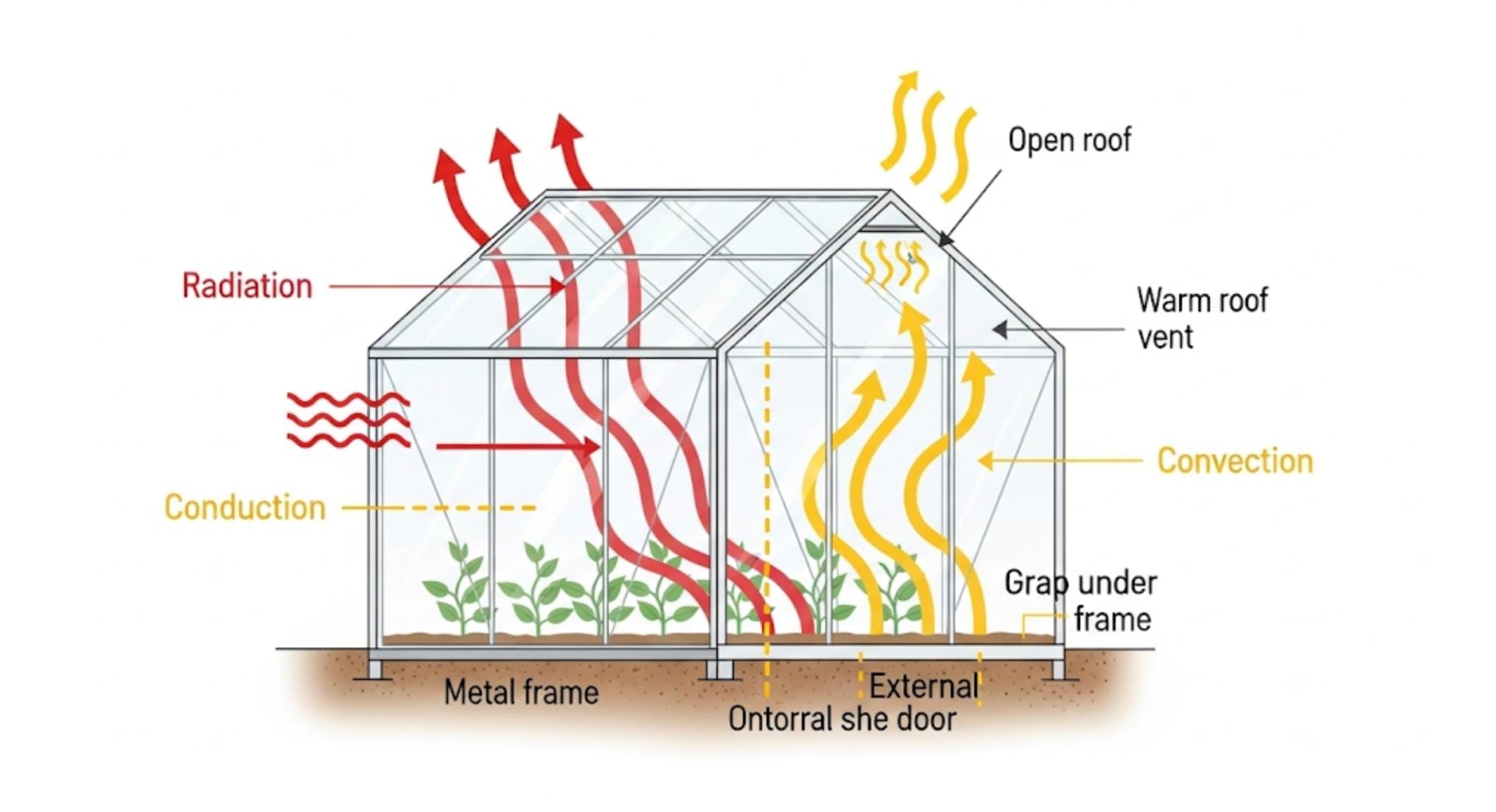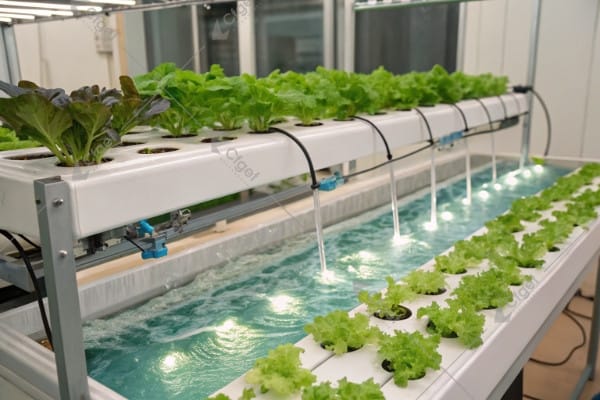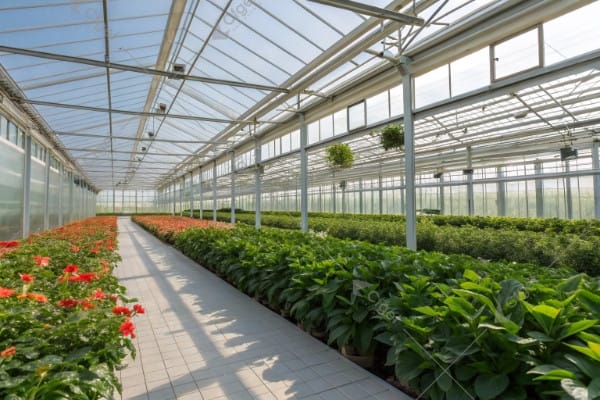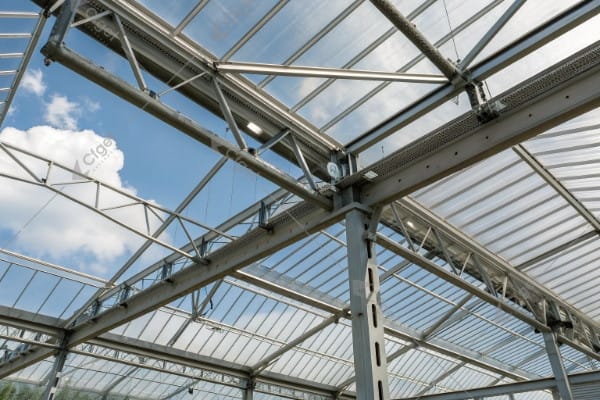Growing tomatoes in a greenhouse seems straightforward until you face stunted plants, inconsistent yields, or disease outbreaks. Without proper techniques, your greenhouse investment yields disappointing results despite your best efforts.
Successful greenhouse tomato cultivation requires selecting appropriate varieties, maintaining optimal climate conditions, implementing effective watering and feeding systems, and mastering pollination techniques. Commercial success depends on integrating these elements with your specific greenhouse design.

Over my 28 years with CFGET designing greenhouse systems across the globe, I’ve witnessed the transformation of greenhouse tomato production. What once required extensive trial and error now follows established best practices backed by research and technology. Our company has helped growers in Thailand achieve 30% yield increases through proper variety selection alone, while European clients have extended growing seasons by 3-4 months with optimized climate control. The knowledge I’ll share today represents lessons learned from hundreds of successful greenhouse installations spanning diverse climates from Southeast Asia to Central Europe.
Don’t Miss:——Is Integrating Hydroponic Systems ‘The Key To Greenhouse Optimization?
You might like:——Growing Perfect Tomatoes: Why a Greenhouse Makes All the Difference
Choosing the Right Tomato Varieties for Greenhouse Growing?
Many greenhouse tomato growers select varieties based on outdoor performance or market popularity alone. This approach leads to poor adaptation to greenhouse conditions, resulting in disease problems and disappointing harvests.
The ideal greenhouse tomato varieties offer indeterminate growth, disease resistance packages tailored to enclosed environments, and production characteristics matching your market needs. Choose between cluster types for consistent quality or larger varieties for premium markets.

I still remember visiting a new client in Central Asia who had invested heavily in greenhouse infrastructure but selected field tomato varieties. Despite perfect environmental controls, their yields remained at just 40% of potential. After switching to proper greenhouse cultivars, their production nearly doubled in the next cycle.
Greenhouse tomato variety selection differs substantially from field production. The enclosed environment creates specific challenges and opportunities that require varieties bred for these conditions. Through our work at CFGET implementing tomato production systems across multiple continents, we’ve identified key selection criteria that consistently lead to successful harvests.
Indeterminate growth habit is essential for maximizing the greenhouse production cycle. These varieties continue growing and producing fruit throughout the season, allowing for extended harvests of 8-12 months in properly managed facilities. When we installed a modern greenhouse system for a grower in Vietnam, we recommended switching from their traditional determinate varieties to indeterminate types. This simple change extended their production season from 4 months to nearly 11 months of continuous harvest.
Disease resistance packages take on heightened importance in greenhouse environments. The higher humidity and limited air movement create perfect conditions for certain pathogens. We always recommend varieties with resistance to at least these key diseases: Tomato Mosaic Virus (ToMV), Verticillium Wilt (Va and Vd), Fusarium Wilt races 1 and 2 (Fol), Leaf Mold (Ff), and increasingly, Tomato Yellow Leaf Curl Virus (TYLCV) in warmer regions. During a project in Thailand, we identified TYLCV as a primary production constraint and implemented a combination of resistant varieties and physical barriers that increased marketable yield by 35%.
Your market requirements should ultimately guide variety selection. For commercial operations serving supermarkets, consistent sizing and appearance often outweigh flavor considerations. Cluster (truss) tomatoes like ‘Endeavour’ or ‘Clermon’ provide exceptional uniformity and post-harvest shelf life. For premium direct-sale markets, varieties like ‘Marnero’ or ‘Maxifort’ grafted with flavorful scions offer superior taste profiles while maintaining greenhouse performance characteristics.
During a recent project in Eastern Europe, we helped a client transition from undifferentiated commodity production to a premium niche market by selecting heirloom-type varieties bred specifically for controlled environments. This strategy increased their per-kilo revenue by 40% while actually reducing production pressure on their greenhouse systems.
Light, Temperature & Humidity: Getting the Environment Right?
Even perfect tomato varieties fail when environmental parameters fall outside acceptable ranges. Many growers struggle with temperature spikes, humidity-related diseases, or inadequate light levels that limit yield potential.
Greenhouse tomatoes require 14-16 hours of light (natural or supplemental), daytime temperatures of 21-27°C (70-81°F), night temperatures of 16-18°C (61-65°F), and relative humidity between 65-75% to maximize production and quality.
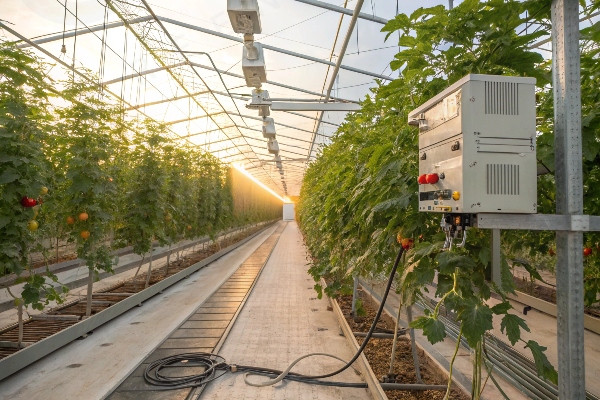
Early in my career with CFGET, I visited a struggling operation in Southeast Asia where tomato plants showed severe leaf curl despite disease-free tests. The problem wasn’t pathological but environmental – daytime temperatures regularly exceeded 32°C, triggering physiological stress. After implementing improved ventilation and shade systems, leaf curl symptoms disappeared and yields increased by 25%.
The greenhouse environment creates the foundation for successful tomato production, and mastering its management requires understanding how these factors interact. Through decades of implementing climate control systems across diverse regions, I’ve observed that getting this balance right often means the difference between thriving plants and constant struggles.
Light management forms the cornerstone of greenhouse tomato production. Tomatoes are high-light crops requiring a Daily Light Integral (DLI) of 22-30 mol/m²/day for optimal production. In Northern Europe and similar high-latitude regions, we routinely install supplemental lighting systems using high-pressure sodium or increasingly, LED fixtures providing 180-220 μmol/m²/s to maintain winter production. During a project in Scandinavia, we implemented an advanced LED lighting system with programmable spectrum control that increased winter yields by 22% while reducing energy costs compared to traditional HPS fixtures.
Conversely, in tropical regions like Southeast Asia, excessive light intensity often requires mitigation. For a client in Thailand, we installed automated shade screens that deployed when light intensity exceeded 800 W/m². This prevented the afternoon photosynthetic shutdown that had been limiting their production and improved fruit quality by reducing sunscald incidents from 12% of harvest to less than 2%.
Temperature management involves more than just maintaining ideal ranges. The temperature differential (DIF) between day and night significantly impacts plant morphology and fruiting. We generally aim for a positive DIF of 5-8°C to promote compact growth and strong flower development. During a greenhouse retrofit in Central Asia, we implemented a climate control system programmed to maintain this differential automatically. The result was stronger plants with improved truss development and a 15% increase in first-quality fruit.
Humidity control presents particular challenges in greenhouse tomato production. The ideal range of 65-75% supports proper transpiration without encouraging disease development. Too low (<60%), and plants experience excessive water stress; too high (>85%), and disease pressure skyrockets. In humid tropical regions, we focus on active dehumidification strategies. For a project in Malaysia, we installed a combination of forced ventilation and minimum pipe temperature controls that maintained humidity levels below the critical 85% threshold even during monsoon season, reducing Botrytis incidents by over 70%.
Carbon dioxide enrichment represents an often-overlooked environmental factor. In sealed modern greenhouses, CO₂ levels can become depleted during peak photosynthesis periods, limiting production. For commercial operations, we typically recommend maintaining 700-900 ppm CO₂ during daylight hours when vents are closed. During a project for a premium producer in Europe, we implemented a liquid CO₂ enrichment system that increased overall yield by 17% with no other changes to their production system.
Watering, Feeding & Support Systems for Greenhouse Tomatoes?
Improper irrigation or nutrition quickly undermines greenhouse tomato success. Many growers struggle with inconsistent watering that stresses plants, or generic feeding programs that don’t match plant needs throughout the production cycle.
Effective greenhouse tomato production requires precision drip irrigation delivering 2-3 liters daily per plant, stage-specific nutrient solutions with EC values between 2.0-3.5 mS/cm, and robust vertical support systems capable of handling plants over 10 meters in length.
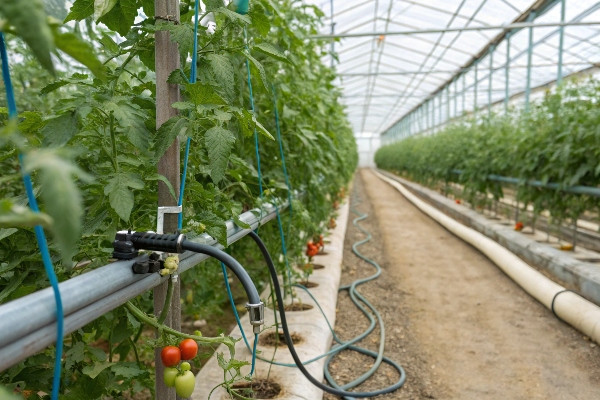
I once visited a tomato operation in Central Asia where plants showed severe blossom end rot despite adequate calcium in their nutrient solution. The issue wasn’t the solution formula but the delivery – their irrigation cycles were too infrequent, creating moisture stress that prevented proper calcium uptake. After adjusting to shorter, more frequent cycles, the problem disappeared entirely.
Water and nutrient delivery systems represent the daily lifeline for greenhouse tomatoes, and getting these elements right requires both precision equipment and management practices tailored to your specific growing environment. Through CFGET’s work implementing greenhouse systems across diverse climates, we’ve refined approaches that consistently deliver results across growing regions.
Irrigation system design must balance delivery precision with operational reliability. For most commercial operations, we recommend pressure-compensated drip emitters1 delivering 2-4 liters per hour, with 1-2 emitters per plant depending on substrate volume. The goal is frequent, small irrigation events rather than infrequent large ones. During our work with a major producer in Europe, we implemented an irrigation system that adjusted automatically based on accumulated light levels rather than fixed time intervals. This approach reduced water usage by 17% while improving fruit size uniformity and reducing cracking incidents.
Substrate selection significantly impacts irrigation strategy. We’ve moved many clients from traditional rockwool to coir-based substrates, which offer improved water-holding capacity and more forgiving irrigation timing. For a client in Southeast Asia dealing with unreliable water pressure, we designed a system using coir slabs with 30% perlite that maintained adequate moisture levels even when irrigation was delayed by up to 6 hours due to power interruptions.
Nutrition programs must evolve throughout the production cycle. Young tomato plants require higher nitrogen ratios (N:K around 1:1) to establish vegetative growth, while fruiting plants need higher potassium levels (N:K around 1:1.5-2) to support quality fruit production. During a project implementation in Thailand, we developed a three-phase nutrition program that automatically adjusted EC and nutrient ratios based on plant development stage. This resulted in a 20% reduction in fertilizer usage while improving Brix levels in the harvested fruit.
Support systems are critical for indeterminate tomatoes that can grow 10-15 meters in length during a full production cycle. The traditional "lower and lean" approach requires robust overhead support wires capable of holding 10-15 kg per plant. For a large-scale producer in Eastern Europe, we engineered a specialized truss support system with steel cables rated for twice the expected load. This eliminated the mid-season structure failures they had experienced previously and reduced labor costs associated with retraining damaged plants.
Irrigation timing strategies often differentiate successful operations. The "irrigation window" approach, where all irrigation occurs within daylight hours (typically starting 1-2 hours after sunrise and ending 1-2 hours before sunset), promotes proper root development and reduces disease pressure. For a client transitioning from soil to soilless production, we implemented this strategy along with moisture sensors that triggered irrigation when substrate moisture dropped below 60%. Their water efficiency improved by 35% while root health indicators showed significant improvement.
Pollination Techniques & Preventing Common Tomato Problems Indoors?
Inadequate pollination leads directly to poor fruit set and reduced yields. Many greenhouse growers underestimate the critical nature of this process or struggle with pest and disease pressures unique to controlled environments.
Effective greenhouse tomato pollination requires mechanical vibration or bumblebee hives (1 hive per 1000m²), while integrated pest management combining biological controls with careful monitoring prevents common problems like whitefly, spider mites, and powdery mildew.

During a consultation in Southeast Asia, I encountered a perplexing case of poor fruit set despite perfect growing conditions. The issue was simple but critical – in their new high-tech greenhouse, air movement was so minimal that pollen wasn’t releasing from the flowers. After introducing bumblebee hives and supplemental air circulation, fruit set percentages jumped from 65% to over 90%.
Pollination represents one of the most fundamental yet frequently overlooked aspects of greenhouse tomato production. Unlike field production, where wind and insects handle this task naturally, greenhouse environments require intervention to ensure proper fruit development. Through our implementation work at CFGET, we’ve refined approaches that ensure consistent results across different operation scales.
For operations under 1 hectare, mechanical vibration often provides the most cost-effective pollination solution. Electric pollination wands vibrating at approximately 30Hz effectively release pollen when used 3-5 times weekly during mid-morning hours when humidity is decreasing but before temperatures peak. During a project with small-scale producers in Central Asia, we introduced a program using rechargeable vibrating wands that increased first-quality fruit production by 25% compared to their previous manual tapping method.
For larger commercial operations, bumblebee pollination has become the industry standard. These efficient pollinators work tirelessly throughout the greenhouse, requiring only proper hive placement and management. We typically recommend one standard hive per 1,000-1,500 m² of greenhouse area, with strategic placement throughout the production space. For a major producer in Europe transitioning from mechanical to biological pollination, we implemented a hive rotation program that maintained consistent pollination activity throughout their 10-month production cycle, improving labor efficiency while maintaining perfect fruit shape characteristics.
Environmental conditions significantly impact pollination success. The ideal temperature range for tomato pollen viability is 21-27°C (70-81°F), with relative humidity between 60-70%. Outside these parameters, pollen either fails to release or loses viability. During a project in the Middle East, we implemented a sophisticated climate control system programmed to create a specific "pollination window" each morning with optimized conditions. This approach increased fruit set from 72% to 94% during the challenging summer months.
Pest management in greenhouse tomatoes requires a proactive integrated approach. Biological control agents form the foundation of sustainable management programs, with predatory mites (Phytoseiulus persimilis) controlling spider mites, parasitic wasps (Encarsia formosa) targeting whitefly, and predatory bugs (Macrolophus pygmaeus) providing broad-spectrum control. During implementation for a client transitioning from conventional to biological control, we designed a banker plant system using eggplants as nursery crops for beneficial insects. This approach reduced their pesticide applications by 85% while maintaining excellent pest control.
Disease prevention focuses primarily on environmental management. Botrytis (gray mold) remains one of the most persistent challenges, requiring careful humidity control and proper plant spacing. For a client in a humid tropical region, we implemented automated dehumidification that activated when relative humidity exceeded 83%. This approach reduced Botrytis incidence by over 60% compared to their previous passive ventilation strategy. Powdery mildew management similarly relies on environmental controls combined with resistant varieties and occasional biological fungicides based on Bacillus subtilis.
Integrated climate and irrigation management provides the most effective long-term disease prevention. By synchronizing irrigation timing with ventilation strategies, we help clients maintain proper plant transpiration that naturally resists disease pressure. During a comprehensive system upgrade for a producer in Northern Europe, we implemented sensors measuring plant transpiration rates to automatically adjust both heating and ventilation parameters. This approach reduced their fungicide applications by 70% while improving overall plant health and production consistency.
Conclusion
Mastering greenhouse tomato cultivation requires integrating variety selection, environmental management, precision irrigation, and effective pollination techniques. By implementing these science-based approaches tailored to your specific greenhouse design and climate conditions, you’ll maximize both yield and quality.
Explore this link to understand how pressure-compensated drip emitters can enhance irrigation efficiency and crop yield. ↩

